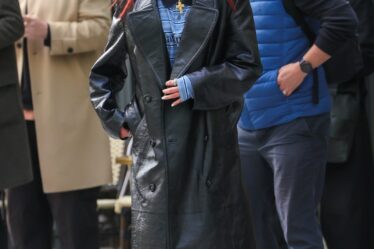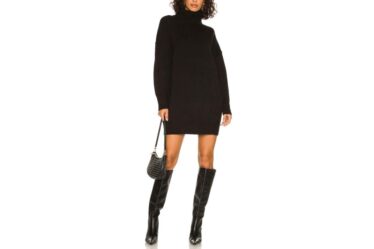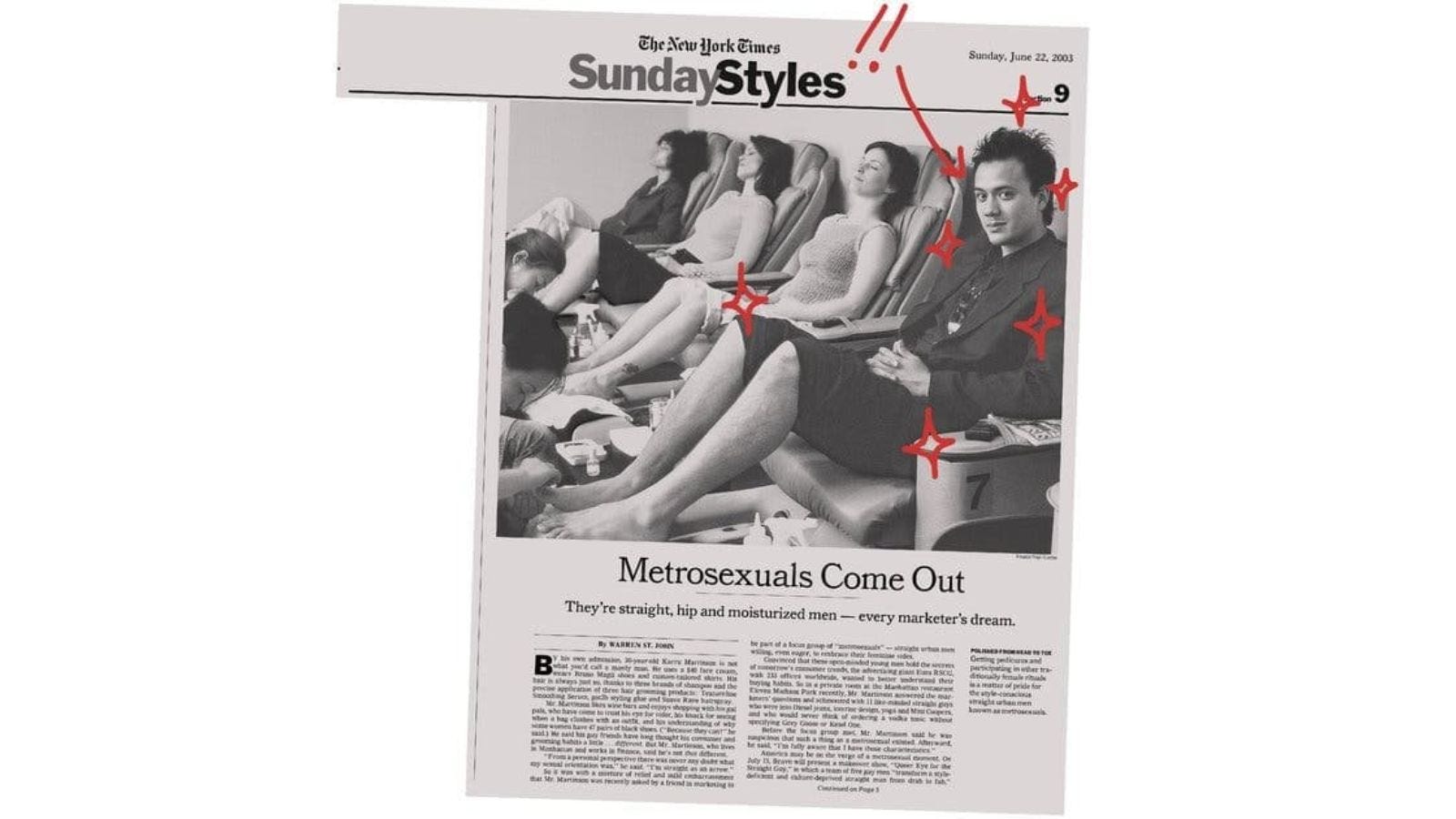
Products are curated by Style Girlfriend editors. Purchases through our links may earn us an affiliate commission.
The metrosexual is dead. Long live the brosexual.
At the risk of trying to make “fetch” happen, I propose a new term for the cultural lexicon:
The brosexual.
A man who embraces style and self-care without apology or fear of stigma. He is, for the most part, straight, but would never dream of distancing himself from the queer community in order to differentiate or defend his interest in fashion and grooming.
Which is lovely! The brosexual stands as a healthy, heartening vision of modern masculinity. A shining bro-beacon on a hill.
Never heard of a metrosexual? You probably also don’t remember school without active shooter drills, or a time when Justin Timberlake wasn’t cringe. So, let’s dive into how we got here.
The Metrosexual Era
The term metrosexual was originally coined in 1994 by the British journalist Mark Simpson. Simpson, who is himself gay, used the word, first in the UK’s Independent and later in a piece for Salon in 2002, to satirize consumerism preying on traditional masculinity.
The rise of the metrosexual, as he saw it, was a response to Madison Avenue turning “unmanly” interests – namely, your appearance – into manly ones.
He opined that the metrosexual was “a collector of fantasies about the male sold to him by advertising” from Calvin Klein underwear to Cool Water aftershave.
By creating an identity around paying attention to one’s appearance, men became consumers. Meaning? Where previously the women in their lives made purchasing decisions for their partners, from the pants they wore to the shampoo they used, men now opened their own wallets to have a say.
A New York Times piece published in 2003 would go on to popularize the term, burning it into the collective consciousness for decades to come.
The opening line:
“By his own admission, 30-year-old Karru Martinson is not what you’d call a manly man. He uses a $40 face cream, wears Bruno Magli shoes and custom-tailored shirts.”
Comical in hindsight, it’s almost hard to imagine someone reading that and chuckling in agreement, thinking, Yes, could you imagine a less manly man?!

Even the headline – “Metrosexuals Come Out” – seems like an ancient relic, an unearthed fossil.
How else could you explain a trend feature detailing “straight urban men willing, even eager, to embrace their feminine sides” without sounding like an archeologist describing the Mesozoic Era to schoolchildren?
Interestingly, the New York Times piece hit newsstands just a month before the original Queer Eye show debuted on Bravo. The now-familiar premise: five gay men make over a straight man each episode, overhauling everything from the clothes in his closet to his romantic approach to his living space.
At its peak, the term was most often used derisively – deployed to suggest a lack of masculinity. But for those with whom the term resonated, to be called a metrosexual was considered as a badge of honor.
After all, it meant you looked better than your merely hetero brethren, and wasn’t that a win?
The Lumbersexual Fad
In the mid-2010s, the pendulum swung, though not all that far in hindsight.
Gear Junkie popularized the term “lumbersexual” in 2014, meant to evoke a man with a rugged, outdoorsy aesthetic.
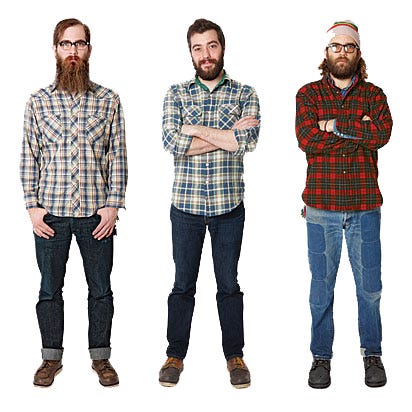

They wrote:
“Today, the metrosexual is a disappearing breed being quickly replaced by men more concerned with existing in the outdoors, or the pseudo-outdoors, than meticulous grooming habits. He is bar-hopping, but he looks like he could fell a Norway Pine.”
These men swapped tailored shirts for flannel ones, and a clean shave for a burly beard (a reason to use even more grooming products!).
The lumbersexual suggested ax throwing as a first date, and stocked up on beard balms.
The concept of the lumbersexual represented a counterpoint to the metrosexual, emphasizing a return to a more “traditionally” masculine image. In reality, however, the vibe leaned more hipster. Think: Ryan Gosling in Red Wing boots at the airport, and less Ron Swanson building a canoe with his bare hands.
After all, most men who identified with the lumbersexual moniker were donning their Buffalo Plaid to wear to their job as an art director or graphic designer, not to fight fires or cut down trees. (My culture is not your costume! said Smoky the Bear.)
Enter the Brosexual: Self-Care Without Self-Loathing
In 2024, a new type of man has emerged: the brosexual.
The brosexual is as interested in his clothes, hair, and skincare as he is in his career, relationships, and the outcome of Game 5 of the NBA Finals. It all matters, and more importantly, it’s okay that it all matters.
Whereas the metrosexual had to defend his grooming routine and wardrobe budget, the brosexual expects social acceptance and validation for taking care of himself.
Moreover, while the metrosexual and lumbersexual identities tacitly implied a cis-het white archetype, the brosexual leans distinctly more diverse.
Barbie actor Simu Liu is a brosexual. So is Bravo’s Andy Cohen.
On social media, brosexual and current People’s Sexiest Man Patrick Dempsy documents a haircut and the tools and product that help him achieve his “McDreamy” look, a Brunello Cucinelli cashmere sweatsuit ‘fit pic, and a stuntman-worthy race car ride all in the same feed.
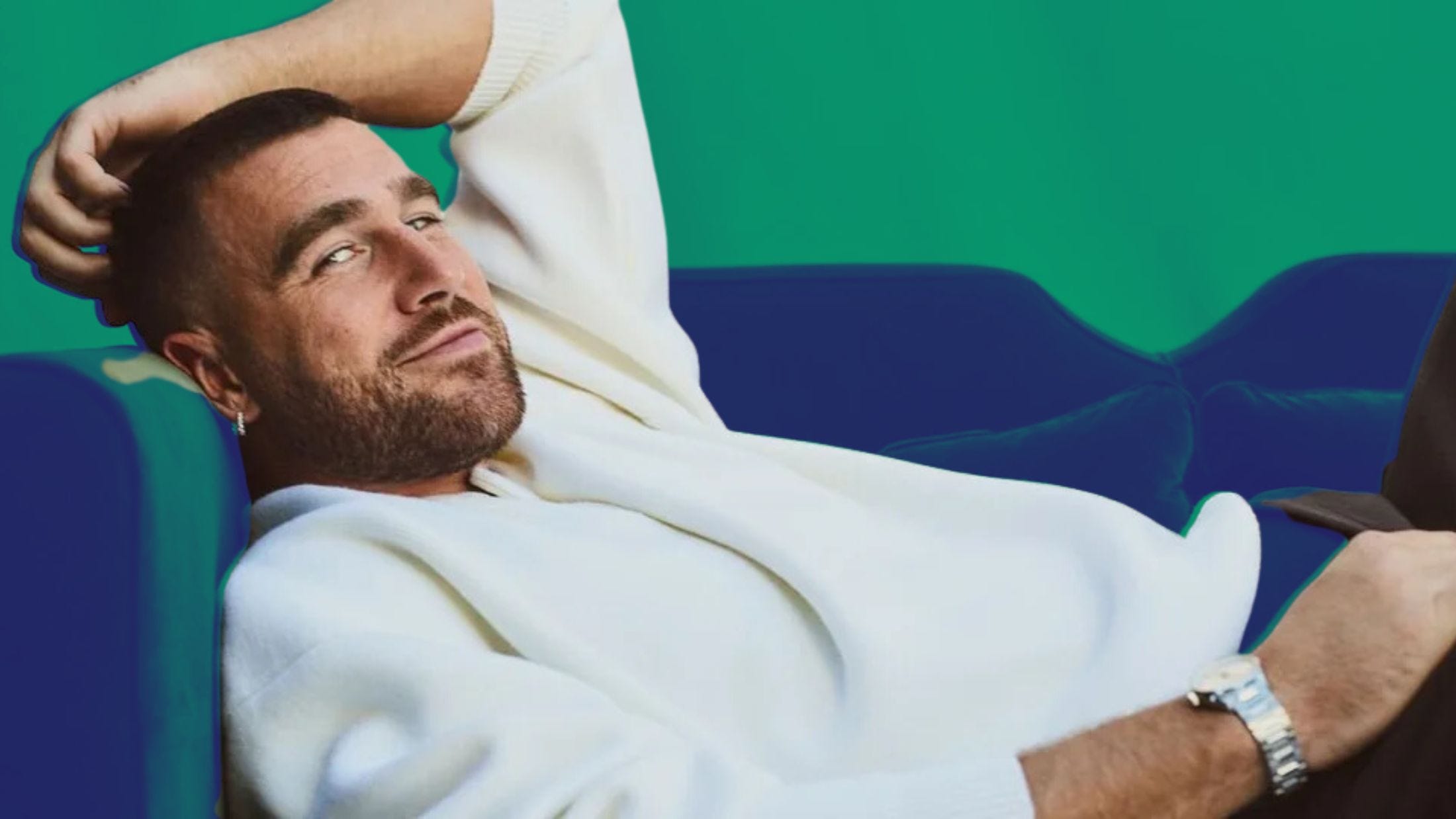

Travis Kelce just may be the unofficial spokesperson for the brosexual.
From tunnel walks that feel like runway walks to expert analysis of his playoff beard, the Kansas City Chiefs tight end demonstrates that caring about both your appearance and clinching another Super Bowl win don’t have to be mutually exclusive.
More brosexuals litter the podcast landscape. The hosts of Throwing Fits. The guys from Pod Save America.
On air, Nate Burleson embraces natural hairstyles on morning television, while Pat McAfee sports bicep-baring tank tops in the afternoon.
The brosexual is as likely to be listening to Kendrick Lamar as Taylor Swift (he was lukewarm on The Tortured Poets Department but has since found a new appreciation after a few listens on a long car ride with his girlfriend).
The brosexual follows Style Girlfriend (!!) on social media or has GQ on his coffee table at home, next to a copy of The Body Keeps The Score.
Brosexual style
The brosexual’s uniform? Tall socks with white running shoes and hybrid performance shorts with a cropped tee from John Elliott, or Abercrombie & Fitch.
A piece of jewelry – from a Rolex to a wedding ring to a pendant necklace – completes the look.
The brosexual grooming routine
Starting with the metrosexual opening the door to a multi-step skincare routine, to the lumbersexual embracing facial hair maintenance, the brosexual today opts for whatever grooming routine works best for him.
That could mean a moisturizer with SPF and a stockpile of pimple patches, or a monthly pedicure on the books.
***
The New York Times‘ Alex Williams got it right when he asked, “‘Metrosexuals’ Were Just Straight Men Who Loved Self-Care. Right?” in a 2018 retrospective piece. And indeed, the Overton window has since shifted enough that taking care of your skin or wanting to wear clothes that fit properly constitutes the baseline, not a big swing, for guys.
What’s more, the divide between the brosexual and the average American man is smaller than ever. Indeed, I’d bet more men today would embrace the brosexual moniker than men in the past would have happily declared themselves a metrosexual or lumbersexual.
The Future of Masculinity: Beyond Labels
Ultimately, to embrace the brosexual trend is to chip away at rigid stereotypes that force men into boxes too small to fit, and to encourage a broader definition of what masculinity can look like.
Of course, there will continue to be (valid!) criticisms of any trend that ::checks notes:: acknowledges the existence of capitalism. As we attempt to wrap our arms around ethically interacting with consumerism, we’ll inherently miss the mark sometimes.
The brosexual understands this movement ultimately focuses on a shift beyond labels and embraces a spectrum of healthy and confident male self-expression. And what’s cooler than that, bro?

